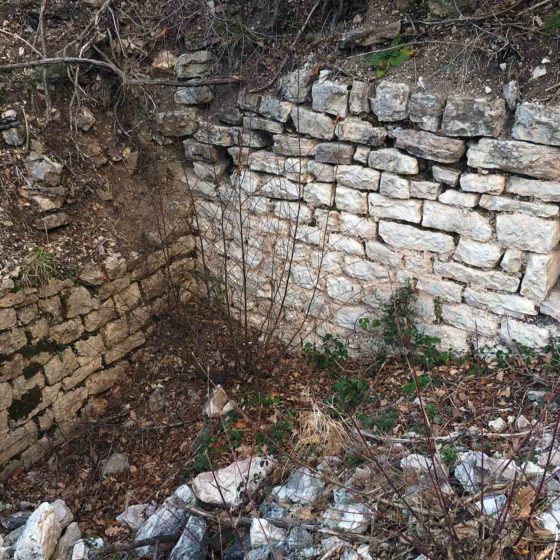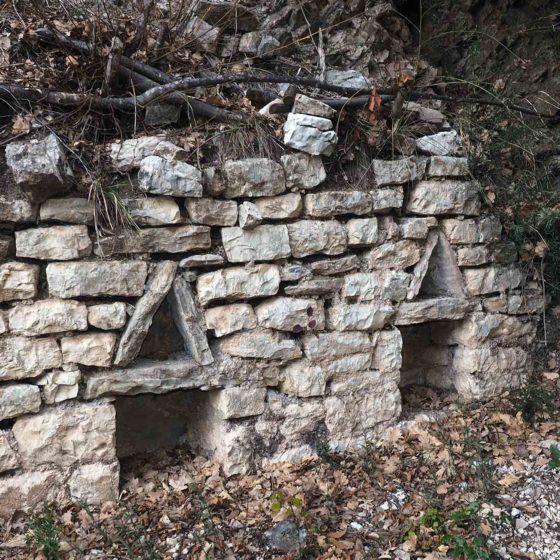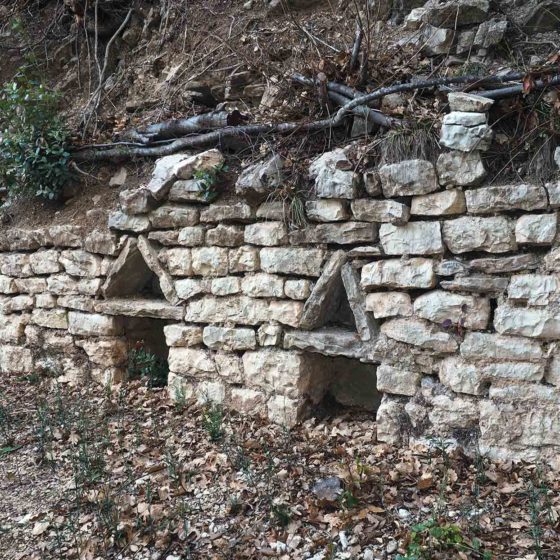Si trova in destra idrografica del fosso dell’Eremita.
I ruderi ancora visibili fanno pensare a una struttura di lunghezza non inferiore a 14 metri per una larghezza di 4 m circa.
Nella parete di monte, a una distanza di 70-100 cm una dall’altra, notiamo non meno di 6 nicchie. Sono larghe e profonde 60-70 cm, in parte ancora ben conservate, con la copertura alla cappuccina che sovrasta un piccolo architrave realizzato con una lastra di pietra.
Nella Historia … di Trevi di Durastante Natalucci (alle pagine 409, 410) leggiamo «[…] L’Eremitorio e Chiesa di Santa Croce esistente sopra al nominato fosso, cognominata della Valle del’Aquila e della Eremita dalla vicina valle e da Eremita abbate del Monastero di Bovara di cui era dominio; dimorandovi, circa il 1258 e seguenti anni, un priore benedettino ed altri abati; indi un priore, dui canonici e dui prebendati secolari […]».
Il 10 dicembre 1571, Monsignor de Lunel, vescovo di Gaeta, visitò la chiesa: «[…] posta in luogo molto remoto ed ombroso… che abita fra’ Deodato calabrese, terziario a quanto afferma egli stesso dell’ordine di S. Domenico; il quale vi sta da molti anni, vestendo un abito piuttosto “silvano”, senza alcun documento scritto, che il visitatore ordinò si ottenesse […]».
Nella stessa occasione Monsignor de Lunel ebbe anche a ordinare: «[…] che l’immagine del Crocifisso, rotta, si accomodasse, oppure venisse bruciata e le sue ceneri messe nel sacrario […]». Evidentemente si optò per la prima soluzione: quel crocifisso è, infatti, giunto sino a noi ed è ora in mostra nella chiesa di Sant’Emiliano a Trevi. Nel 1713, anche il vescovo Lascaris visitò questa chiesa lasciando l’interessante descrizione che riportiamo di seguito: «[…] questa è antichissima, e di ignota origine… Ha una struttura antichissima con due porte, un unico altare con l’immagine del Ss. Salvatore dipinta nel muro, del tutto spoglio. Del monastero antico ora restano le vestigia di certe stanze annesse, ad uso dell’eremita […]».
RUINS OF THE HERMITAGE CHURCH OF SANTA CROCE IN VAL DELL'AQUILA
The ruins are located on the hydrographic right of the ‘fosso dell’Eremita’ [‘Hermit’s ditch’].
The still visible ruins suggest a structure of no less than 14 metres in length and about 4 metres in width.
In the mount oriented facade, at a distance of 70-100 cm from each other, there are no less than 6 cavities. These are 60-70 cm wide and deep, some of them are still well preserved, with a ‘cappuccina’cover roof over a small stone architrave.
In the Durastante Natalucci’s ‘Historia di Trevi…’ (pages 409, 410) we read (in an ancient italian language): «[…] The Hermitage and Church of Santa Croce above the afore mentioned cavity, known as the Valle del’Aquila e della Eremita from the nearby valley and from the abbot of the Monastery of Bovara, whose dominion; About 1258 and subsequent years, a Benedictine prior and other abbots lived there; another prior, two canons and two secular prebendaries […]»
On 10th December 1571, Monsignor de Lunel, bishop of Gaeta, visited the church: «[…] located in a very remote and shady place… which is inhabited by brother Deodato from Calabria, a tertiary of the Order of St. Dominic, who, according to his own statements, has been living there for many years, wearing a rather ‘sylvan’ habit, without any written document, which the visitor asked for to be obtained […]».
On the same occasion, Monsignor de Lunel also ordered that «[…] the image of the Crucifix, broken, to be restored or burned and its ashes placed in the shrine […]». Evidently the first solution was opted for it: the crucifix, in fact, has been inherited back to us and it is now visible in the church of Sant’Emiliano in Trevi.
In 1713, Bishop Lascaris visited this church as well, leaving the following interesting description reported here after: «[…] this is it … very old, and of unknown origin… It has a very old structure with two doors, a single altar with the image of the Holy Saviour painted on the wall, completely bare. Of the ancient monastery there are just the remains left of some adjoining rooms, for the only use of the hermit […]».
The translation of this post is edited by Patrizia ANTONELLI


